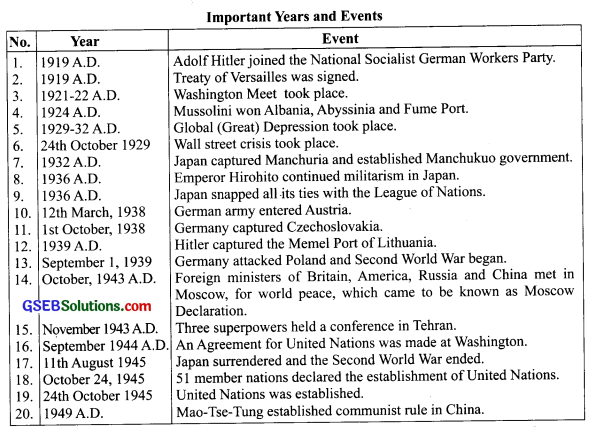Our Revision Notes for GSEB Class 9 Social Science Notes Chapter 3 Movement Towards a New World summarises the key points of a chapter and useful resource to prepare effectively for the upcoming board exams.
Movement Towards a New World Class 9 GSEB Notes Social Science Chapter 3
Movement Towards a New World Class 9 GSEB Notes
→ After the first world war many government in Europe failed to resolve economic problems. As a result, people lost faith in democracy.
→ This led to emergence of dictatorship in Italy, Germany and Japan.
→ This new trend led to outbreak of the second world war.
→ Injustice fascism in Italy dealt by the allied powers at the Paris peace conference. This has caused tremendous resentment among the people of Italy
![]()
→ Benito Mussolini took the advantage of this situation and found the fascist party. ‘A bunch of sticks and axe’ was the symbol of the fascist party. Its volunteers were given military training and wore black uniform.
→ One party, one leader’ was the maxim of Mussolini. He left the league of nations and joined ‘Rome-Berlin-Tokyo axis’.
→ Due to Nazism in Germany defeat in the first World war had caused deep resentment and • discontent in Germany. An unjust and humiliating Treaty of Versailles was imposed on Germany.
→ Adolf Hitler founded The national socialist German workers Party, known as the Nazi Party in 1919. He became the President of Germany after the death of Von Hindenburg and thereafter established dictatorial rule. The German people regarded him as the Fuherer – the saviour.
→ The volunteers of the Nazi Party wore brown uniform, with red stripes on their shoulders, having reverse Swastika symbol.
![]()
→ According to the treaty of Versailles Japan got the benefit of China. In the 1921 -22 Washington meet, Japan had to agree to have only 35% of English and American force.
→ Japan also had to vacate the islands of Sakhalin and Siberia. The Japanese youth was angry.
→ Japan adopted expansion policy and started compulsory military training.
→ In 1929-32 Japan left the League of Naion.
→ The wall street crisis on 24th October, 1929 led to Great Economic Depression. It shattered the world economy.
→ Causes of the second world war ‘
→ After the first world war fierce nationalism emerge in Germany, Japan, and Italy.
→ The injustice in Treaty of Versailles caused discontent which led to the emergence of the Fascist party in Italy, Nazi party in Germany and Militarism in Japan.
![]()
→ Groupism:- After the first world war, France, Italy and Russia had entered, into treaties with other nations. The world was divided between the Axis power and the Allied powers.
→ Militarism:- European nations were engaged in the manufacture of destructive weapons. Japan and America joined the race. The strength of Army, Navy and Airforce was enhanced.
→ Failure of the League of Nations:- The greed of power amongst several nations became stronger in the League of nations. It could not stop groupism.
→ Treaty of Versailles:- This treaty sown the seeds of of the second world war as it had humiliated Germany. Adolf Hitler discarded the Treaty and called it ‘a piece of paper’.
→ Imperialists ambition of Adolf Hitler:- He annexed Austria, Czechoslovakia and Mamal port of Lithunia in March 1939. The Germany attack on Poland was an immediate cause of Second
world war.
![]()
→ The world was again divided into two groups Allied Nations led by England and France. On the other side was the group of Axis Nations comprising Germany, Italy and Japan.
→ Japan attacked the American Navy at Pearl Harbour.
→ Asa result America joined the war.
→ America dropped Atom bombs on the two Japanese cities, Hiroshima and Nagasaki, in order to stop Japan from moving any further.
→ Japan surrendered on 1 st August 1945 and World war II came to an end.
→ Effects of the Second World War: All the involved nations had incurred huge expenses which adversely affected the World economy.
→ Mao-Tse-Tung brought about the Communist Revolution and formed government on 1st October, 1949.
→ Cold war started between the America and USSR. The war of words and the war of ideologies that both super powers initiated in order to support or oppose each other’s opinion created the atmosphere of Cold War.
→ At the end of World war II, on 24th October, 1945, the United Nations was established with the purpose of peace, security and co existence in the world.
![]()
→ Its headquarters was to be in New York.
The structure, adopted by the United Nations to achieve its aims, includes 6 organs:
- General Assembly
- Security Council
- Economic and Social Council
- Trusteeship council
- International Court of Justice
- Secretariat
